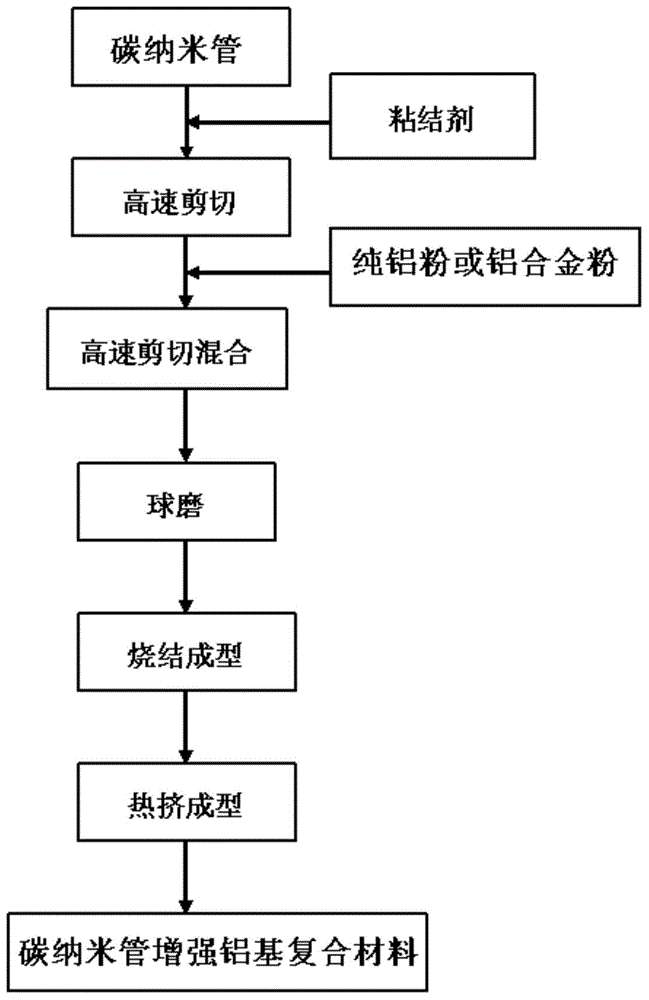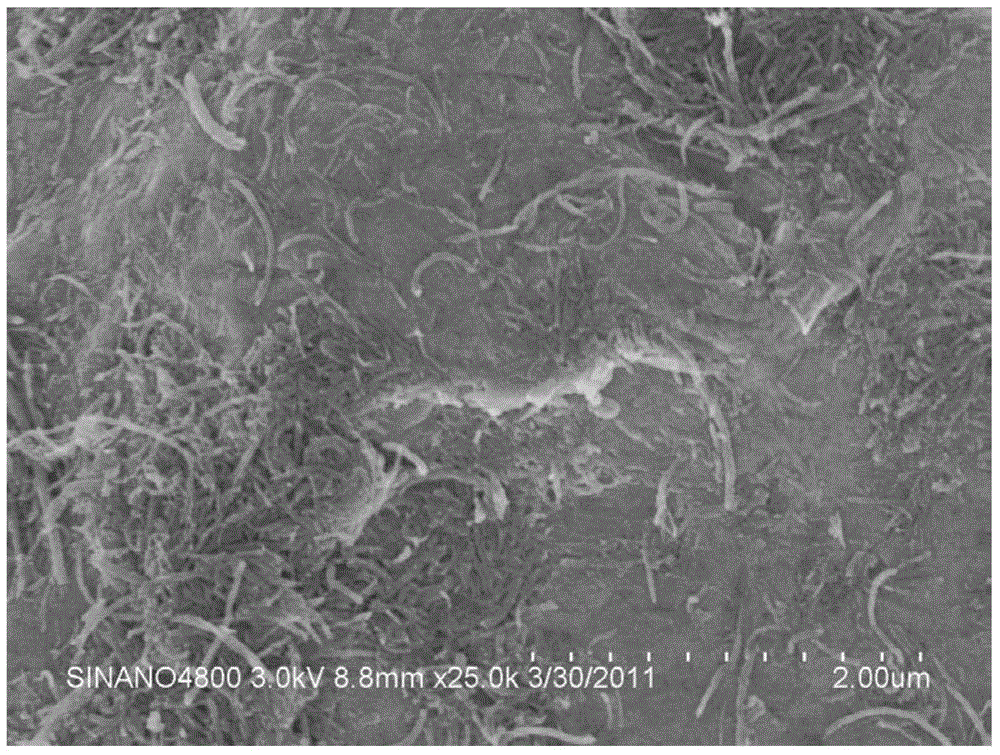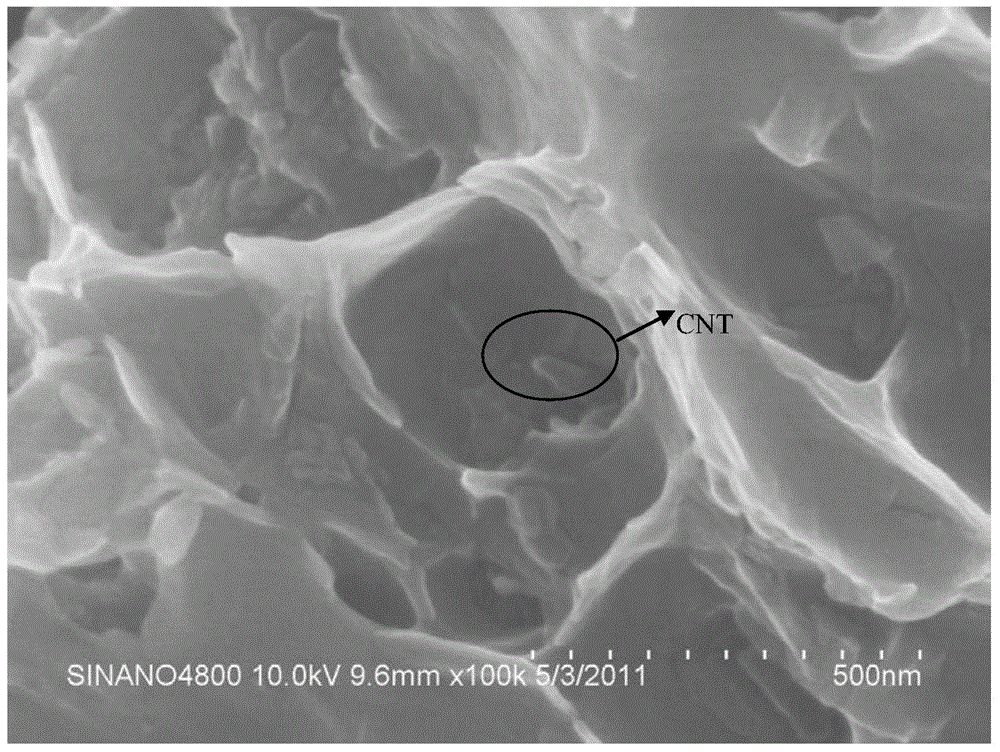Carbon-nanotube-reinforced aluminum-base composite material
A technology of carbon nanotubes and reinforced aluminum matrix, which is applied in the field of aluminum matrix composite materials, can solve the problems of cumbersome procedures, high cost, and ineffective combination, and achieve simple process, improved tensile strength and wear resistance, and low equipment investment. low effect
- Summary
- Abstract
- Description
- Claims
- Application Information
AI Technical Summary
Problems solved by technology
Method used
Image
Examples
Embodiment 1
[0028] Such as figure 1 As shown, the preparation of carbon nanotube-reinforced aluminum matrix composites:
[0029] 1) Pre-disperse carboxylated carbon nanotubes with a tube diameter of 30-50nm in a pulverizer, pulverize at a speed of 500rpm for 10min, then add liquid paraffin and mix with a high-speed shearer at a speed of 500rpm for 10min to make the liquid paraffin Evenly coat the surface of carboxylated carbon nanotubes, then add pure aluminum powder with a particle size of about 15 μm and mix at a speed of 500 rpm for 10 minutes, then take it out, so that carboxylated carbon nanotubes are evenly distributed on the surface of pure aluminum powder, and the first Composite powder, by weight percentage, the content of each component in the first composite powder is: carboxylated carbon nanotube 1%, liquid paraffin 0.1% and pure aluminum powder of the balance;
[0030] 2) Put the obtained first composite powder into a ball mill, and take it out after ball milling at a speed ...
Embodiment 2
[0035] Such as figure 1 As shown, the preparation of carbon nanotube-reinforced aluminum matrix composites:
[0036] 1) Pre-disperse carboxylated carbon nanotubes with a tube diameter of 30-50nm in a pulverizer, pulverize them at a speed of 400rpm for 15min, then add stearic acid and then mix them with a high-speed shearer at a speed of 400rpm for 15min to make hard Fatty acid is uniformly coated on the surface of carboxylated carbon nanotubes, and then pure aluminum powder with a particle size of about 25 μm is added and mixed at a speed of 400 rpm for 15 minutes, then taken out, so that carboxylated carbon nanotubes are evenly distributed on the surface of pure aluminum powder, and the obtained The first composite powder, by weight percentage, the contents of each component in the first composite powder are: 5% carboxylated carbon nanotubes, 0.8% stearic acid and the balance of pure aluminum powder;
[0037] 2) Put the obtained first composite powder into a ball mill, ball mi...
Embodiment 3
[0041] Such as figure 1 As shown, the preparation of carbon nanotube-reinforced aluminum matrix composites:
[0042] 1) Pre-disperse carboxylated carbon nanotubes with a diameter of 30-50nm in a pulverizer, pulverize them at a speed of 300rpm for 20min, then add polyvinylpyrrolidone and then mix them with a high-speed shearer at a speed of 300rpm for 20min to make the polyvinylpyrrolidone Vinylpyrrolidone is evenly coated on the surface of carboxylated carbon nanotubes, and then pure aluminum powder with a particle size of about 25 μm is added and mixed at a speed of 300 rpm for 20 minutes, then taken out, so that carboxylated carbon nanotubes are evenly distributed on the surface of pure aluminum powder, and the obtained The first composite powder, by weight percentage, the contents of each component in the first composite powder are: 6% carboxylated carbon nanotubes, 2% polyvinylpyrrolidone and the balance of pure aluminum powder;
[0043] 2) Put the obtained first composit...
PUM
| Property | Measurement | Unit |
|---|---|---|
| particle diameter | aaaaa | aaaaa |
| strength | aaaaa | aaaaa |
| elastic modulus | aaaaa | aaaaa |
Abstract
Description
Claims
Application Information
 Login to View More
Login to View More - R&D
- Intellectual Property
- Life Sciences
- Materials
- Tech Scout
- Unparalleled Data Quality
- Higher Quality Content
- 60% Fewer Hallucinations
Browse by: Latest US Patents, China's latest patents, Technical Efficacy Thesaurus, Application Domain, Technology Topic, Popular Technical Reports.
© 2025 PatSnap. All rights reserved.Legal|Privacy policy|Modern Slavery Act Transparency Statement|Sitemap|About US| Contact US: help@patsnap.com



